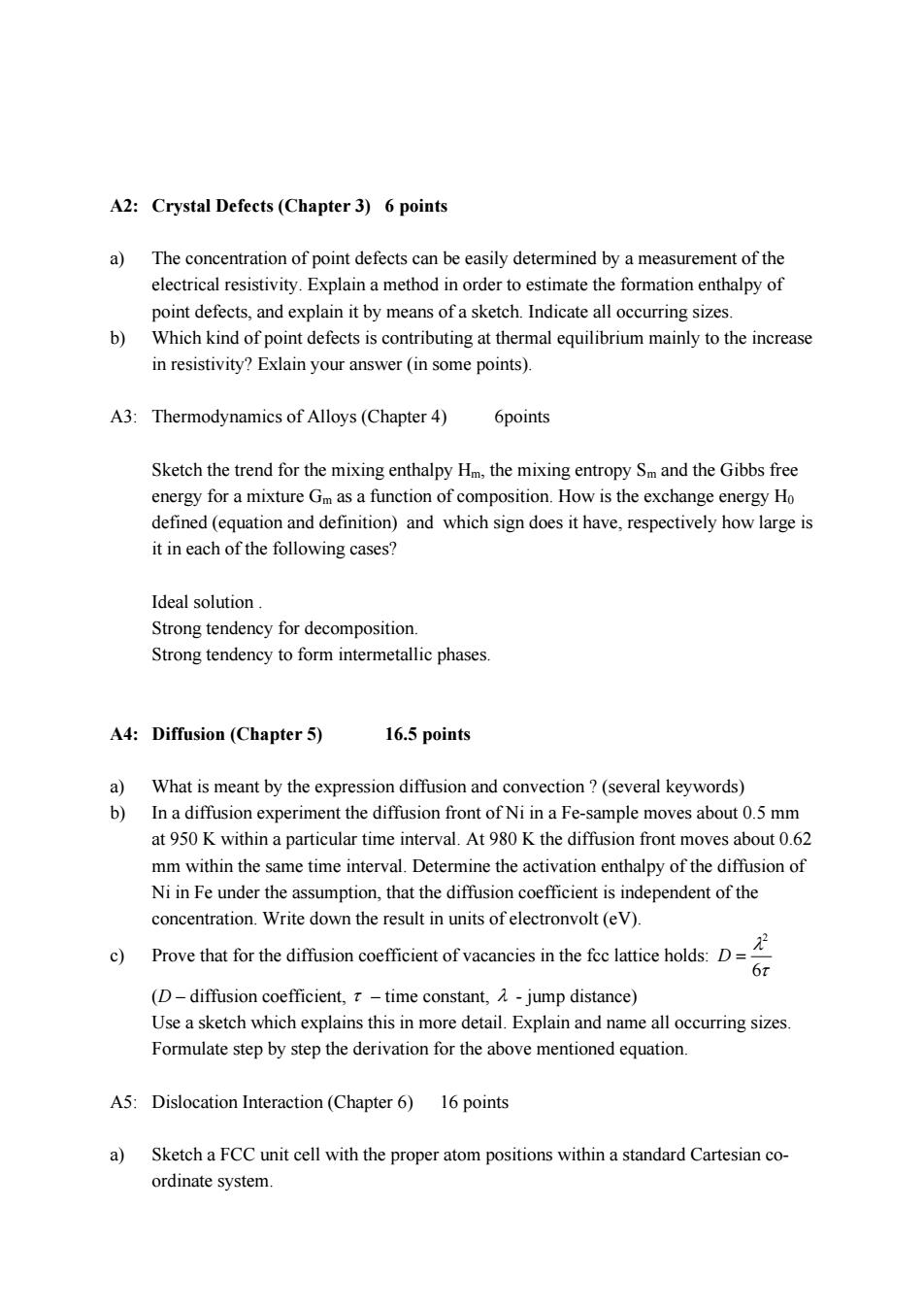正在加载图片...

A2:Crystal Defects(Chapter 3)6 points a)The concentration of point defects can be easily determined by a measurement of the electrical resistivity.Explain a method in order to estimate the formation enthalpy of point defects,and explain it by means of a sketch.Indicate all occurring sizes. b)Which kind of point defects is contributing at thermal equilibrium mainly to the increase in resistivity?Exlain your answer(in some points). A3:Thermodynamics of Alloys(Chapter 4) 6points Sketch the trend for the mixing enthalpy Hm,the mixing entropy Sm and the Gibbs free energy for a mixture Gm as a function of composition.How is the exchange energy Ho defined (equation and definition)and which sign does it have,respectively how large is it in each of the following cases? Ideal solution. Strong tendency for decomposition. Strong tendency to form intermetallic phases. A4:Diffusion(Chapter 5) 16.5 points a)What is meant by the expression diffusion and convection?(several keywords) b)In a diffusion experiment the diffusion front of Ni in a Fe-sample moves about 0.5 mm at 950 K within a particular time interval.At 980 K the diffusion front moves about 0.62 mm within the same time interval.Determine the activation enthalpy of the diffusion of Ni in Fe under the assumption,that the diffusion coefficient is independent of the concentration.Write down the result in units of electronvolt(eV). )Prove that for the diffusio cofficient ofvacances inth eatichos 67 (D-diffusion coefficient,-time constant,-jump distance) Use a sketch which explains this in more detail.Explain and name all occurring sizes. Formulate step by step the derivation for the above mentioned equation. A5:Dislocation Interaction(Chapter 6)16 points a)Sketch a FCC unit cell with the proper atom positions within a standard Cartesian co- ordinate system.A2: Crystal Defects (Chapter 3) 6 points a) The concentration of point defects can be easily determined by a measurement of the electrical resistivity. Explain a method in order to estimate the formation enthalpy of point defects, and explain it by means of a sketch. Indicate all occurring sizes. b) Which kind of point defects is contributing at thermal equilibrium mainly to the increase in resistivity? Exlain your answer (in some points). A3: Thermodynamics of Alloys (Chapter 4) 6points Sketch the trend for the mixing enthalpy Hm, the mixing entropy Sm and the Gibbs free energy for a mixture Gm as a function of composition. How is the exchange energy H0 defined (equation and definition) and which sign does it have, respectively how large is it in each of the following cases? Ideal solution . Strong tendency for decomposition. Strong tendency to form intermetallic phases. A4: Diffusion (Chapter 5) 16.5 points a) What is meant by the expression diffusion and convection ? (several keywords) b) In a diffusion experiment the diffusion front of Ni in a Fe-sample moves about 0.5 mm at 950 K within a particular time interval. At 980 K the diffusion front moves about 0.62 mm within the same time interval. Determine the activation enthalpy of the diffusion of Ni in Fe under the assumption, that the diffusion coefficient is independent of the concentration. Write down the result in units of electronvolt (eV). c) Prove that for the diffusion coefficient of vacancies in the fcc lattice holds: τ λ 6 2 D = (D – diffusion coefficient, τ – time constant, λ - jump distance) Use a sketch which explains this in more detail. Explain and name all occurring sizes. Formulate step by step the derivation for the above mentioned equation. A5: Dislocation Interaction (Chapter 6) 16 points a) Sketch a FCC unit cell with the proper atom positions within a standard Cartesian coordinate system